Table of Contents
Table of Contents
Welcome to the world of networking, where data travels at lightning speed across vast distances, bringing people and devices closer than ever before. However, like any superhero, even the most powerful networks have their kryptonite: packet loss.
Packet loss may seem harmless, like a tiny ant on an elephant's back, but in reality, it's the invisible enemy of network performance. It can disrupt your video calls, slow down your downloads, and even crash your online gaming session.
No matter the size or scope of your business, network connectivity and performance are essential for any business’ operations. From video conferencing and VoIP, to cloud-based applications and remote work, businesses rely heavily on the network to stay connected and productive. However, network performance can be severely impacted by packet loss, one of the most common issues that IT professionals face.
So, if you've ever wondered why your internet is acting up, or if you're just curious about how the magical world of networking really works, then buckle up and join me on this journey to unravel the mystery of packet loss. In this article, we’re going to explore what packet loss is, how packet loss impacts network performance, and how to reduce packet loss to minimize its impact on businesses.
As you probably saw from the title of this article, packet loss is the Invisible Enemy of Network Performance.
Packet loss is a network issue that occurs when data packets being transmitted over a network (or between devices or across the Internet) get lost or dropped during transit and fail to reach their destination. Incomplete or delayed data transmission can impact network and application performance and affect the user experience.
Packet loss can be inbound or outbound:
- Inbound Packet Loss → With inbound packet loss, packets coming to your network are lost before they arrive.
- Outbound Packet Loss → With outbound packet loss, packets sent from your network never reach their destination.
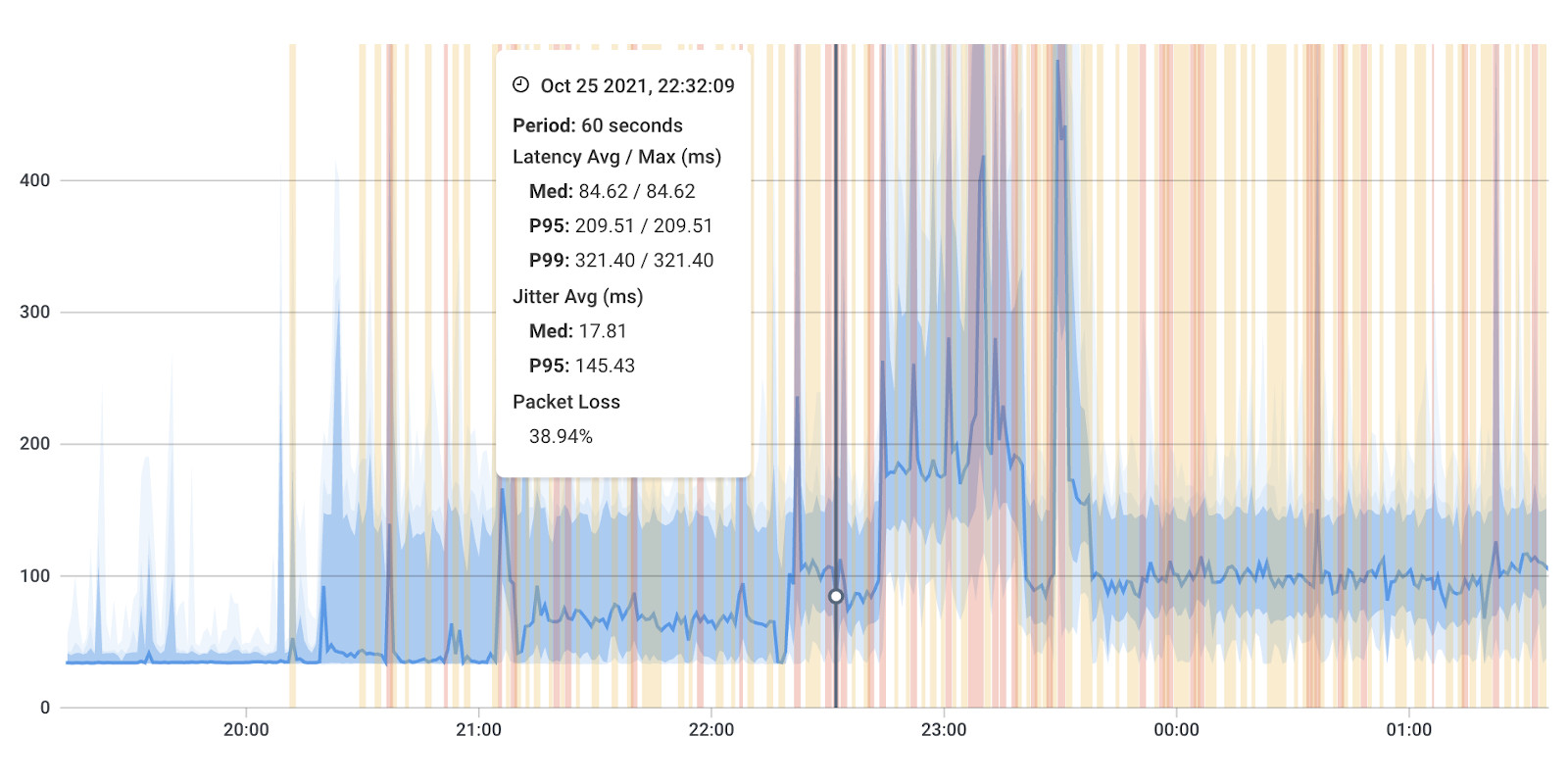

So, imagine you’re mailing a letter to a friend, and you write a long message on a piece of paper. To send this letter, you fold it, put it in an envelope, write the address on the envelope, and then drop it in a mailbox. Here, the message on the piece of paper represents a data packet, the envelope represents the network protocol used to transport the packet, and the mailbox represents the network device transporting packet to its destination.
Let's say that the envelope containing your letter gets damaged during transit and some parts of the message become illegible. If too much of the letter is lost or damaged during transit, your friend may not receive the complete message, and the communication will be incomplete.
This is similar to packet loss in a network.
When data packets are lost or corrupted during transmission, it leads to incomplete or unusable data at the receiving end. And, if there is too much packet loss on the network, the data being transmitted may become incomplete or unusable, causing issues for the user.
In both cases, it's important to ensure that the message or data being transmitted arrives at its destination without any errors or loss. By identifying and troubleshooting network packet loss, network administrators can help ensure that data is transmitted reliably across the network - just like ensuring that your message reaches your friend in one piece!

Understanding packet loss is crucial for anyone working with computer networks, whether it be network administrators, IT professionals, or even everyday users. Here are some reasons why understanding packet loss is important:
- Impact on network performance: Packet loss can have a significant impact on network performance. When packets are lost, the data they contain must be retransmitted, leading to delays and reduced network throughput. Understanding how packet loss occurs and how to mitigate it can help improve network performance and reduce the impact of packet loss on user experience.
- Impact on specific applications: Certain applications are particularly sensitive to packet loss, such as real-time applications like VoIP and video conferencing. For these applications, even small amounts of packet loss can result in poor call quality and dropped connections. Understanding packet loss can help network administrators optimize their networks for these applications and ensure that they perform as expected.
- Troubleshooting network issues: Packet loss is often an indicator of underlying network issues. Understanding how to measure and interpret packet loss can help network administrators identify and troubleshoot these issues quickly and efficiently.
- Security implications: Packet loss can also be caused by security measures such as firewalls and intrusion detection systems. Understanding the impact of these security measures on packet loss can help network administrators strike a balance between security and network performance.
- Planning for future growth: As networks grow and evolve, the potential for packet loss also increases. Understanding packet loss can help network administrators plan for future growth and ensure that their networks can handle increased traffic and higher performance demands.
Packet loss can be caused by a variety of different factors, and not all of them are easy to identify. For businesses with large enterprise networks, having a tool to monitor packet loss helps you understand what is causing packet loss in your network.
Packet loss can be caused by:
Network Congestion occurs when there is high network traffic, data packets can be delayed or dropped due to limited bandwidth. When a network becomes congested, the available bandwidth decreases, and the routers and switches may drop packets to alleviate the congestion.
The distance separating two points in a network can add to network congestion, with greater distances increasing the likelihood of bottlenecks and consequent packet loss. For instance, transmitting data across continents may encounter more network congestion due to the increased distance.
Network congestion is typically a fleeting problem but may indicate a larger underlying issue in the network, such as malfunctioning or overburdened devices or inadequate network configurations, that can lead to irritating network issues affecting packet loss and other performance measures.
Faulty hardware, such as damaged cables or faulty network devices, can also cause packet loss. This can include issues with network interfaces, routers, switches, or other network devices. Outdated or malfunctioning equipment can cause packets to be dropped or delayed, resulting in reduced network performance.
- Processing Power: Insufficient processing power is a frequent culprit of packet loss in layer 3 network devices like routers or firewalls. These devices are tasked with directing and managing network traffic, but without adequate processing power to handle the traffic, packets may be dropped or delayed. This is particularly the case with customer firewalls, where resource-intensive security features can further strain the device's processing capabilities.
- Physical Cabling: Packet loss can also result from the physical cabling utilized in a network. Ethernet cables may sustain damage or experience electromagnetic interference, both of which can compromise signal quality and lead to packet loss. Fiber optic cables may be subjected to kinking or damage, and their connectors may accumulate dirt and necessitate cleaning. In addition, optic transmitters may produce low signals, or the distance between the transmitter and receiver may be too great for the signal to reach the receiver with an acceptable strength, ultimately resulting in packet loss.
Bugs or glitches in network software can also cause packet loss. This can include improperly configured network device software or bugs in the software, firmware, or operating system code, which can cause unexpected behavior, including dropped or delayed packets.
To prevent packet loss caused by software bugs, IT professionals need to be vigilant in their monitoring and management of network software, firmware, and operating systems. Regular software updates, firmware updates, and operating system updates can help prevent bugs from occurring or fix them when they do.
Some security measures, such as firewalls or intrusion detection systems, may block or filter certain types of data packets, resulting in packet loss. If these security measures are too strict or misconfigured, they may block or drop packets, leading to packet loss.
For example, firewalls or intrusion detection systems may be configured to block or filter certain types of data packets that are deemed to be a security risk. But, this can result in legitimate data packets being dropped or delayed, leading to packet loss.
IT professionals must exercise caution when configuring security measures to avoid inadvertently blocking legitimate data packets and causing packet loss. This may involve devising security policies that permit necessary data packets while blocking potential threats.
Moreover, IT professionals must regularly supervise and update security measures, including monitoring firewalls, to confirm that they are performing as anticipated and not contributing to packet loss.
Latency, aka, long distances between network devices or multiple network hops can increase the likelihood of packet loss. High latency can be caused by long distances between network devices or multiple network hops, and, when latency is high, it can cause delays in the delivery of data packets, increasing the likelihood of packet loss.
For Example: Consider the scenario where a company's headquarters are in one country and its branch office is in another. The physical distance between these two locations can result in elevated latency. Furthermore, if data must traverse several network hops to reach its destination, latency may further escalate, leading to a higher incidence of packet loss.
QoS settings may prioritize certain types of network traffic over others, leading to packet loss for less important traffic. IT professionals can employ Quality of Service (QoS) settings to assign priority to network traffic based on its importance, guaranteeing that vital applications, like VoIP or video conferencing (QoS for VoIP), are prioritized over less crucial traffic, such as email or file transfers. Although QoS can assist in ensuring that critical traffic is transmitted reliably and with minimal delay, it can also potentially generate packet loss in certain situations.
- Rate Limiting: traffic shaping or rate limiting limits the amount of bandwidth available for certain types of traffic to ensure that they do not overwhelm the network. However, if the limit is set too low or if there is a sudden surge in traffic, packets may be dropped due to congestion, resulting in packet loss.
- Buffer Management Techniques: In order to manage network congestion, routers and switches typically use buffers to temporarily store packets that cannot be transmitted immediately. However, if the buffer becomes full, incoming packets may be dropped to make room for new traffic, resulting in packet loss.
- QoS Misconfigurations: If QoS policies are not properly configured, packets may be dropped or misrouted, resulting in packet loss.
Routing issues can also cause packet loss. When packets are sent from one device to another, they may travel through several intermediate devices, such as routers and switches, before reaching their destination. If there is a problem with the routing table or if the destination device is not reachable, the intermediate devices may drop the packet.
In addition to technical factors, non-technical factors such as environmental interference or electromagnetic interference (EMI) can also cause packet loss. EMI can cause data corruption and signal interference, leading to packet loss and other network issues.
Note that, not all packet loss is avoidable, and some level of packet loss is to be expected with packet-based communication over a network. However, it’s important for network administrators to measure the amount of packet loss, and identify and address the underlying causes of packet loss to minimize its impact on network performance and user experience.
Learn about the common causes of packet loss to quickly identify & resolve network issues & minimize the impact on network performance and businesses.
Learn more

Packet loss is measured as a percentage of the total number of packets sent versus those received. ICMP pings are a common method for testing packet loss, which includes sending multiple pings and measuring the percentage of packets that are lost. For example, if you ping a device 50 times and only receive 49 responses, you can estimate that packet loss is about 2% at that moment.
1. Measure Packet Loss with Ping
There are several ways to measure packet loss, but one common method involves sending a series of packets from one device to another and monitoring the number of packets that are lost along the way. This technique is often referred to as "ping" or "ping testing," and it involves using a software tool that sends a small packet of data to a remote device and waits for a response.
If the remote device responds, the software knows that the packet arrived successfully. If there is no response, or if the response is delayed, the software considers the packet lost. By repeating this process with multiple packets, the software can calculate the percentage of packets that were lost during the test.
2. Measure Packet Loss with Network Monitoring Tools
Another way to measure packet loss is to use specialized network monitoring tools that can capture and analyze network traffic in real-time. These tools can provide detailed information about network performance, including packet loss, latency, and other critical metrics, and they can help network administrators identify and troubleshoot issues before they impact end-users.
To accurately measure and monitor packet loss for all your network applications, use a tool like Obkio Network Performance Monitoring software, which continuously measures packet loss by sending synthetic UDP packets every 500ms, and recording how many packets are dropped in transmission.

Continuously measuring packet loss every minute is essential for obtaining an accurate percentage of packet loss in your network. Learn more in our article on How to Measure Packet Loss.
Measuring the percentage of packet loss is important for understanding the impact on your network. Low levels of packet loss (less than 1-2%) are considered acceptable for most applications, but higher levels of packet loss can cause significant issues with network performance and user experience.
A network monitoring tool, like Obkio, continuously measures packet loss at the required frequency to ensure it catches the earliest signs of packet loss.

To begin monitoring packet loss, you need to deploy Network Monitoring Agents which continuously measure network performance in key network locations. Here’s what we recommend:
- Local Agents: Installed in the targeted office location experiencing packet loss issues. There are several Agent types available (all with the same features), and they can be installed on MacOS, Windows, Linux and more.
- Public Monitoring Agent: Which are deployed over the Internet and managed by Obkio. They compare performance up to the Internet and quickly identify if the problem is global or specific to the destination. For example, measure packet loss between your branch office and Google Cloud.
Once you’ve set up your Monitoring Agents and they’ve started collecting data, you can easily identify and monitor any packet loss is happening in your network on Obkio’s Network Response Time Graph.
The dashboard shows a significant amount of packet loss that increased over time and ended up increasing even more on July 24th.
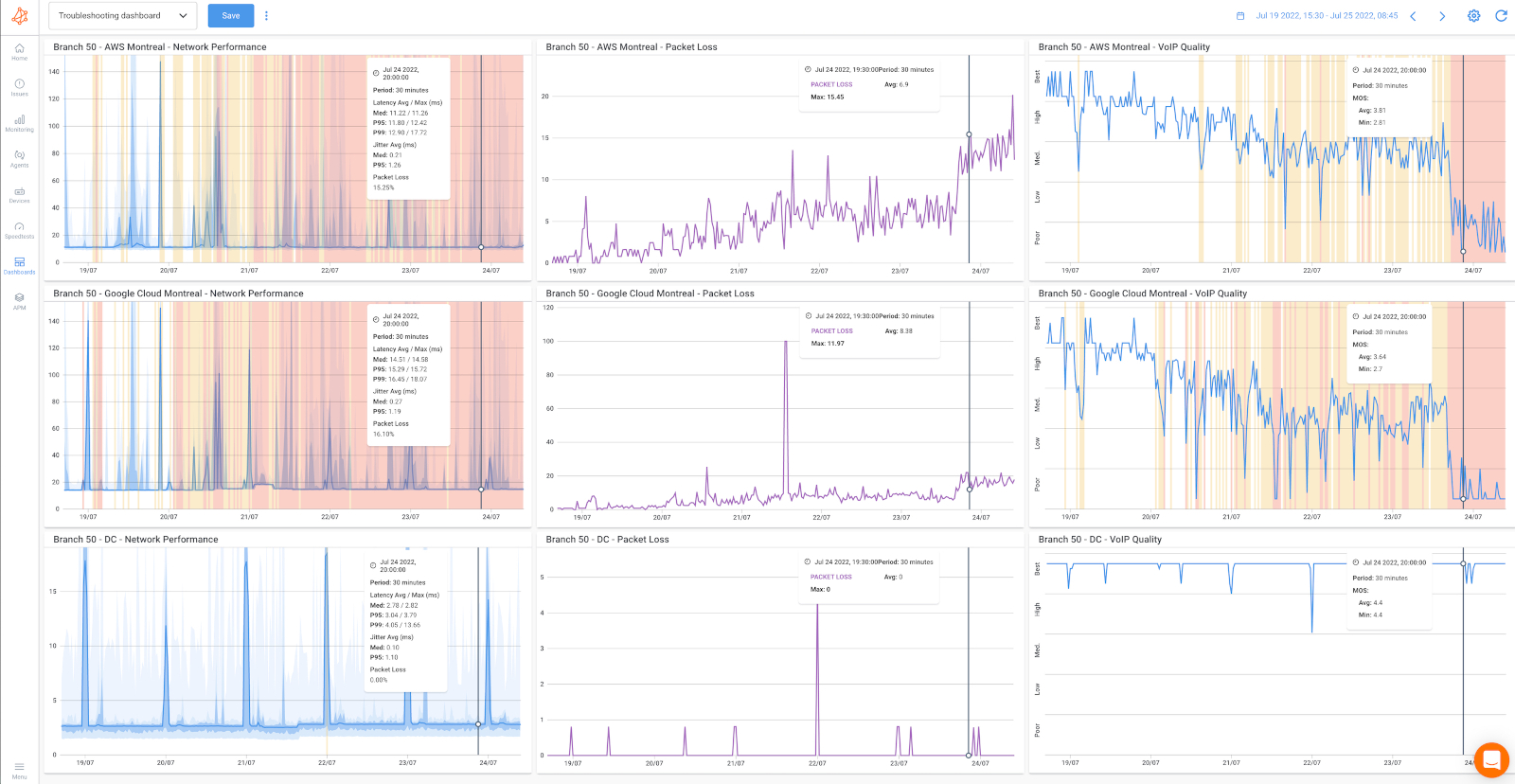
The packet loss is only happening towards Internet destinations (first two rows targeting AWS and Google Cloud Platform), since there’s no issue reaching the data center (as shown on the last row of graphs).
This can be explained because the data center is reached via an MPLS link and the Internet is reached via a local Internet connection on branch 50. This client didn’t prioritize the notification about packet loss and let the situation continue, which ended up significantly affecting the users of the branch.
As we mentioned above, packet loss can have a significant impact on network performance and user experience. Which is why it’s important to measure packet loss. in your network to address the possible causes, or troubleshoot before it causes larger issues.
I. The Impact of Packet Loss on Network Performance
When data packets are dropped in transit across the network, it can result in delayed or incomplete data transmissions, causing a range of issues, such as:
- Reduced Throughput: Packet loss can slow down the network's performance as data needs to be retransmitted.
- Increased Latency: Lost packets can cause delays in data transmission, leading to increased latency or delay times.
- Jitter: When packets are lost, the timing of the remaining packets can become unpredictable, leading to jitter, or fluctuations in latency.
- Poor Quality of Service (QoS): If packet loss is severe or frequent, it can impact the QoS of network applications, such as video streaming, VoIP, or other unified communication applications.
- Network Congestion: In some cases, packet loss can lead to network congestion, causing a backlog of data that further slows down the network's performance.
- Reduced Bandwidth: Packet loss can cause a reduction in available bandwidth, as the network may need to re-transmit lost packets, leading to slower data transfer rates.
- Corrupted Data: When packets are lost, the data they contain can become corrupted, leading to errors in applications and data corruption.
- Disrupted Network Services: Packet loss can cause disruptions in network services, leading to downtime, slow performance, and even loss of revenue for businesses.
To prevent packet loss, it’s essential to identify and troubleshoot any underlying network problems, such as high bandwidth usage, outdated hardware, or network congestion.
II. The Impact of Packet Loss On Businesses & User Experience
So packet loss can clearly affect network and application performance, but it doesn’t stop there. Besides the direct impact, it can also have a significant impact on user experiences and businesses, particularly those that rely on network applications to operate.
- Increased Support Time and Costs: If customers or employees experience issues due to packet loss, businesses may need to provide additional support to resolve these issues, resulting in increased support costs. But remember, you can use Obkio’s Network Performance Monitoring tool to avoid and troubleshoot packet loss.
- Poor User Experience: Packet loss can cause slow loading times, buffering, or dropped calls for customers or users of a business's online services, leading to a poor customer experience and potential loss of business.
- Reduced Productivity: If network applications are slow or unresponsive due to packet loss, employees may be less productive, resulting in decreased output and increased costs.
- Damaged Reputation: If a customer-facing network application is slow or unreliable due to packet loss, it can damage a business's reputation and make it less attractive to customers and partners. Additionally, employees may experience a poor user experience, which can make them less likely to recommend their employer.
- Security Risks: Packet loss can be a sign of network security issues, such as cyber attacks or malware infections, which can compromise a business's data and operations.
- Lost Revenue: If network applications are slow or unresponsive due to packet loss, it can lead to lost revenue due to decreased sales, missed opportunities, or decreased efficiency.
Overall, packet loss can have a significant impact on a business's operations, reputation, and bottom line. By monitoring and troubleshooting packet loss, businesses can improve network performance and minimize the impact on their operations and customers.
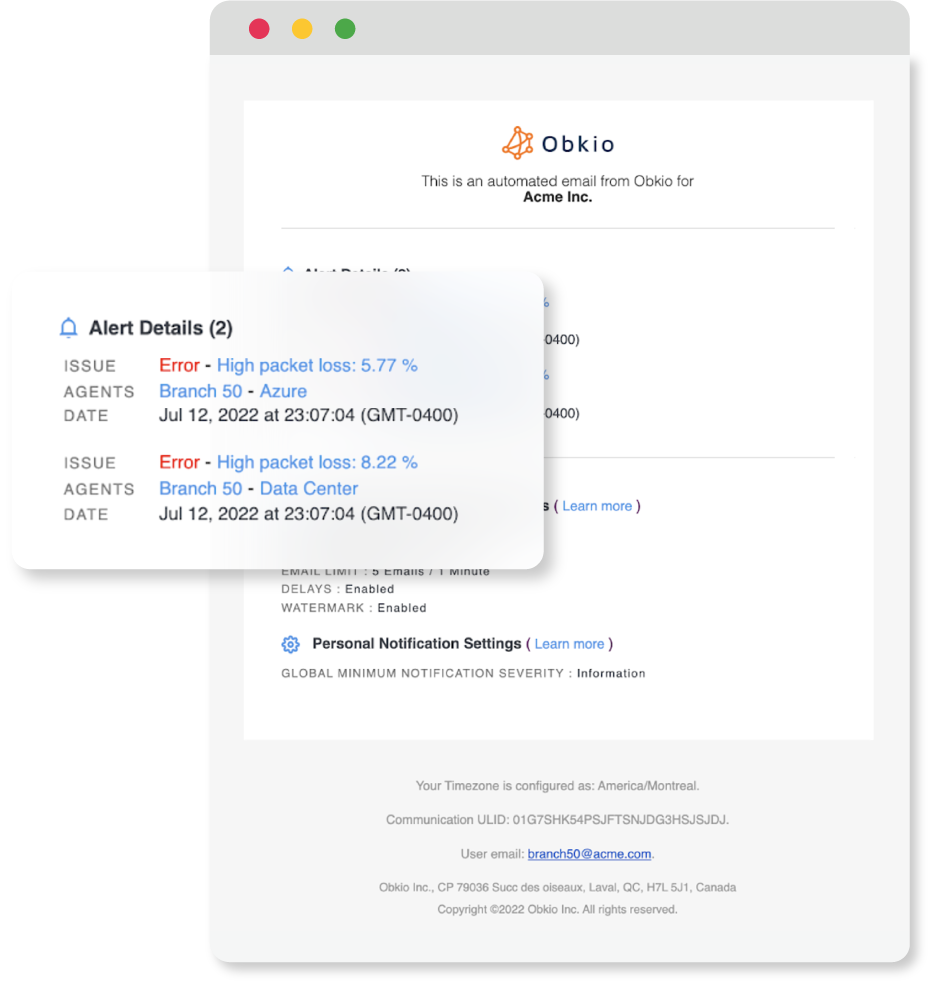

You can't really see packet loss in your network (being that it's an invisible enemy and all), but there are various methods that you can use to detect packet loss in other ways. Some of these methods include:
Synthetic Network Monitoring: Synthetic network monitoring involves simulating network traffic using specialized software. The synthetic traffic (such as UDP, TCP, HTTP) travels through your network to simulate the end-user POV and detect packet loss affecting network performance, applications and services. You can perform synthetic monitoring using Obkio Network Performance Monitoring software, which continuously tests packet loss by sending synthetic UDP packets every 500ms to check for packet loss during transmission.
Ping: One of the easiest and most common methods to detect packet loss is by using the ping command. The ping command sends an ICMP echo request to a designated IP address and measures the time it takes for the echo reply to return to determine whether packets are being lost. If the echo reply does not return or takes an unusually long time to return, it's usually clear indication of packet loss.
Traceroute: Another method to detect packet loss is by using the traceroutes. Traceroutes trace the path of packets from the source to the destination and collect information about the number of hops and the response time of each hop, which can help identify where packet loss is occurring on a network.
Router Logs: Router logs can also be used to detect packet loss. Router logs can provide information about packet loss rates, the source and destination of lost packets, and other network-related issues.
Packet Capture: Packet capture is a more advanced method for detecting loss which requires specialized software and skills to use and analyze the captured data packets. It provides information about network traffic, including the number of packets sent and received, the response time of each packet, and the percentage of packets that were lost, but can be expensive, time-consuming and hard to scale in enterprise networks.
By using these methods, network administrators can detect packet loss and take steps to improve network performance and reduce the impact of packet loss on their network.
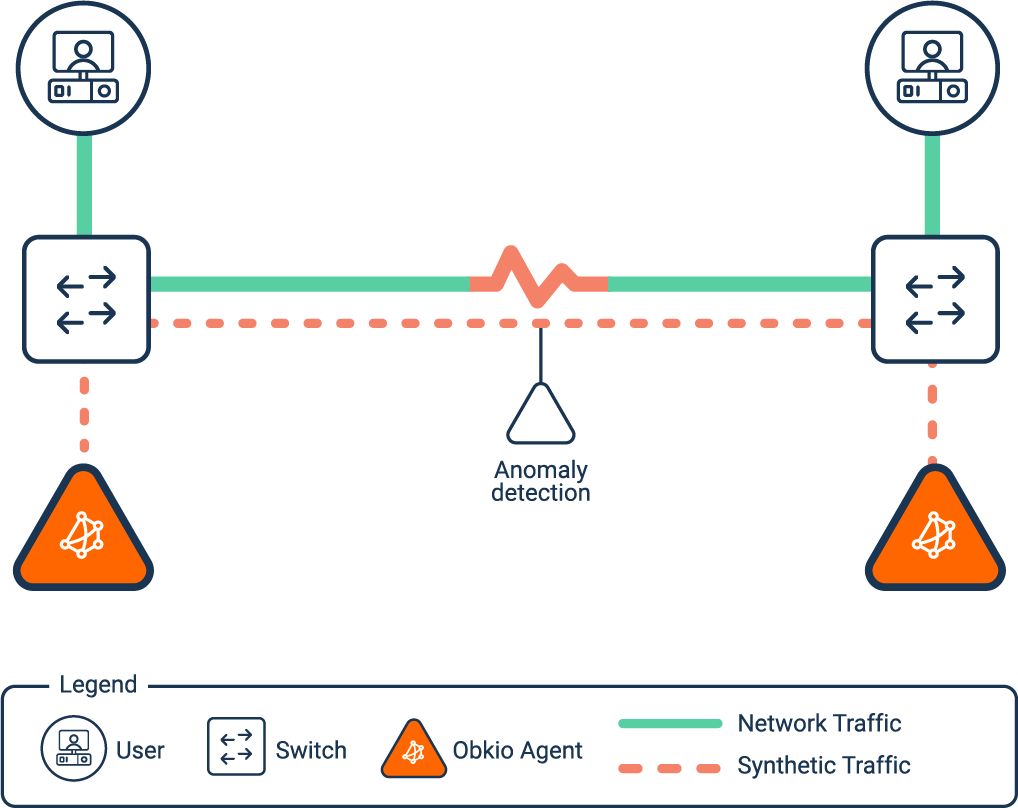
Note: ICMP tests like Ping and Traceroutes aren’t processed by routers like TCP or UDP packets, which can lead to less accurate results. Additionally, they can still experience dropped packets, which can also lead to false positives or false negatives. Therefore, IT pros should use ICMP testing in combination with other methods for detecting packet loss, like Synthetic Network Monitoring.
Some level of packet loss is expected in any network, even in well-designed and well-maintained networks. However, the acceptable level of packet loss varies depending on the type of network and the application being used. Different levels of package loss can affect your network and applications in different ways. The level of acceptable packet loss varies depending on the type of network application and the specific requirements of the users.
For example, in a local area network (LAN) where data transmission is generally fast and reliable, packet loss of less than 1% is generally acceptable. On the other hand, in a wide area network (WAN) where data transmission is slower and more prone to errors, packet loss of up to 3% may be considered acceptable.
In general, a low level of packet loss (1%-2%) is considered acceptable for most applications, while higher levels of packet loss can significantly impact the performance and reliability of the network. In general, packet loss rates of 5% or higher are considered high and can significantly impact network performance and user experience.
For real-time applications such as video conferencing (Zoom), voice over IP (VoIP), a low level of packet loss is critical to ensure smooth and uninterrupted communication. Typically, packet loss levels of 1% or less are considered acceptable for these types of applications, although even lower levels of packet loss may be required for high-quality, high-definition streams.
High packet loss can lead to dropped calls, choppy audio, or frozen video, which can disrupt communication and reduce productivity. VoIP monitoring takes into account a set of network metrics related to VoIP Quality, including packet loss, and indicates what is acceptable or not.
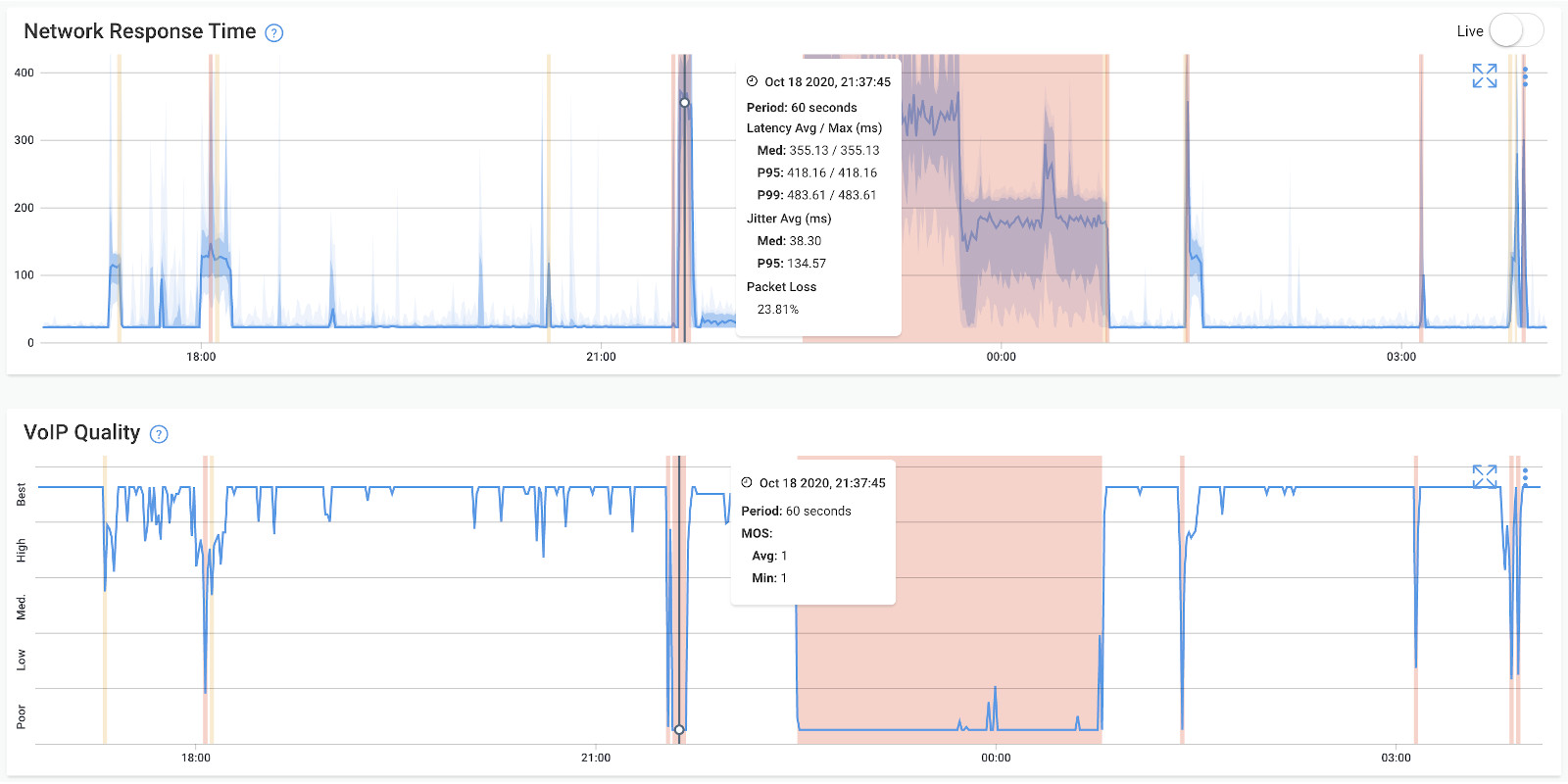
For non-real-time applications such as email, file transfers, and web browsing, a slightly higher level of packet loss can be acceptable, as long as it does not significantly affect the overall user experience. Packet loss levels of up to 5% may be considered acceptable for these types of applications.
But high packet loss levels can still cause slow loading times, incomplete downloads, or corrupted files.
Ultimately, the level of acceptable packet loss or high packet loss depends on the specific needs and requirements of the network users, as well as the nature of the applications being used.
For most applications, a packet loss rate of 1% or less is considered acceptable. Beyond that, packet loss starts to have a noticeable impact on the quality of real-time applications like voice and video calls, online gaming, and streaming. In more sensitive applications like online gaming or voice/video conferencing, even a packet loss rate as low as 0.5% might be noticeable.
However, in scenarios where reliability is crucial, such as financial transactions, critical data transfers, or remote surgery applications, even extremely low packet loss rates might be considered unacceptable. In these cases, networks and communication systems are designed with redundancy and error correction mechanisms to minimize the chance of any data loss.
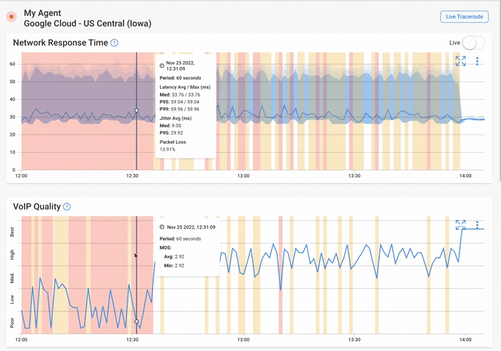
An Example of High Packet Loss
Let's consider when employees are using a cloud-based video conferencing platform for important meetings and presentations. In this scenario, high packet loss could have a significant impact on the business operations.
Imagine that during a critical board meeting where key decisions are being discussed, the video conferencing application experiences a packet loss rate of around 10%. This means that 10% of the video and audio data packets being sent from one participant's computer to another participant's computer are not successfully received.
The consequences of high packet loss in this context could include:
- Poor Video and Audio Quality: With a 10% packet loss rate, participants might experience frequent freezes or stutters in the video feed, making it difficult to follow presentations and discussions. Audio might cut in and out, leading to miscommunication and frustration.
- Miscommunication: High packet loss can result in parts of the conversation being lost, causing confusion and misunderstandings. Key points and details could be missed, leading to flawed decision-making.
- Reduced Engagement: Participants might become disengaged if they're struggling to understand the content due to poor quality. This can affect the effectiveness of the meeting and the ability to convey important information.
- Disrupted Flow: The flow of the meeting can be disrupted due to the constant interruptions caused by packet loss. This can slow down discussions and make the meeting less productive.
- Time Wastage: If packet loss is severe, participants might need to pause and repeat themselves frequently, wasting valuable meeting time and potentially extending the duration of the meeting.
- Negative Impressions: Clients, partners, or other external stakeholders involved in the meeting might form negative impressions of the company's professionalism and technological capabilities due to the poor quality of the video conferencing experience.
In this scenario, a 10% packet loss rate would likely be considered quite high, as it significantly hampers the effectiveness of the business communication. The business might need to take actions such as troubleshooting network issues, upgrading network infrastructure, or exploring alternative communication methods to ensure that critical meetings are conducted without disruption.
In networking, "good" packet loss is generally characterized by a very low or negligible percentage of packet loss. As mentioned earlier, packet loss can negatively impact network performance and the quality of communication or data transmission. Therefore, the lower the packet loss, the better the network's performance and user experience.
For most standard networking applications, a packet loss rate of 1% or lower is often considered acceptable and can be deemed as "good." This means that out of every 100 packets sent, no more than 1 packet is lost in transit.
In more sensitive and real-time applications, such as voice or video conferencing, online gaming, and streaming, an even lower packet loss rate is desirable. In these scenarios, a packet loss rate of 0.1% (or 0.001) or lower might be considered "good" because any higher level of packet loss could lead to noticeable disruptions or quality degradation in the transmitted content.
However, in certain critical contexts where data integrity is of the utmost importance, such as financial transactions or medical data transmission, a "good" packet loss rate might be practically zero. These scenarios often involve robust error correction mechanisms and redundant paths to ensure minimal to no data loss.
Ultimately, what's considered "good" packet loss depends on the specific application, the nature of the data being transmitted, and the tolerance of the users or systems involved. Lower packet loss rates contribute to smoother communication, more reliable data transfer, and an overall better user experience.
Troubleshooting packet loss involves systematically identifying the source of the issue and taking steps to address it. We have a whole seperate article about Troubleshooting Packet Loss, but we'll give you a shortened step-by-step guide here:
Use network monitoring tools to confirm whether packet loss is occurring. In the screenshot below, you’ll see an example of a Network Session with no packet loss. As a reference, this is what it looks like when the packet loss isn’t the cause of your problem.
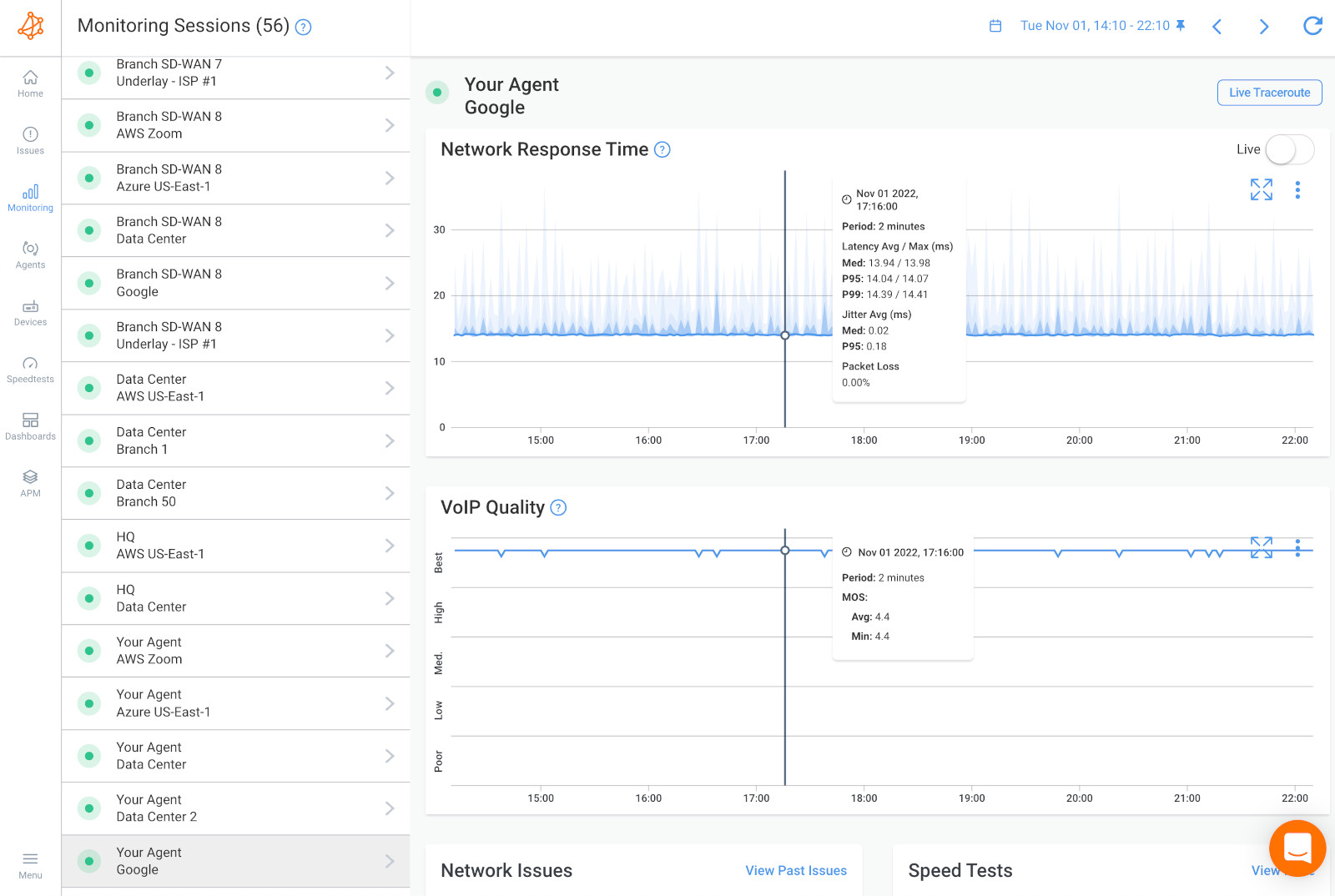
- High latency, interrupted audio/video, and slow data transfers can be indicators of packet loss.
- If it’s not a network issue, it might be a user issue. You can install a Monitoring Agent directly on a user’s workstation to see the issue from their point-of-view.
- At this point, it may just be a problem that IT specialists can solve directly on the user's workstation or on the remote destination
Determine if the packet loss is affecting specific applications, devices, or a broader network segment. This helps narrow down the troubleshooting focus. You can use Obkio to isolate the issue.
- If the packet loss is happening on a network segment that is common to both network sessions. This means that the problem is broader and not exclusive to a single network path or destination. This could be in the LAN, the firewall or the local loop Internet connection.
- When packet loss is limited to a single network session, it indicates that the issue is specific to the communication between your network and a particular destination.
When troubleshooting packet loss, it's important to assess whether the problem is isolated to a single device or if it's impacting multiple devices on your local network. By testing packet loss on various devices, you can narrow down the scope of the issue and gather important information about its potential causes.
- Test packet loss on different devices within your local network. If multiple devices experience packet loss, it's likely a network-wide issue.
- Analyze the data collected through Obkio's Device Monitoring feature to assess if the packet loss is happening internally, within your network
By testing multiple devices for packet loss, you can observe different outcomes that provide valuable insights:
- No Packet Loss on Any Device: If you find no packet loss across all tested devices, it suggests that the network is performing well and the issue might be isolated to a specific application, service, or destination.
- Packet Loss on Multiple Devices: If multiple devices experience packet loss, it indicates that the issue is likely network-wide rather than being limited to a single device or connection.
- Packet Loss on One Device: If only one device is experiencing packet loss, the issue might be related to the device itself, its network settings, or its connection to the network.
In a scenario where packet loss is observed on both network sessions, this can point to a resource issues like high bandwidth or network congestion.
- Use Obkio to detect network congestion by generating synthetic traffic and monitoring the load on your network. This will help you understand if your network is being congested by large amounts of traffic.
- Measure bandwidth to ensure your network's bandwidth can handle the current load. Consistently high levels of bandwidth utilization suggests that the network link(s) may be saturated or insufficient to handle the traffic demands.
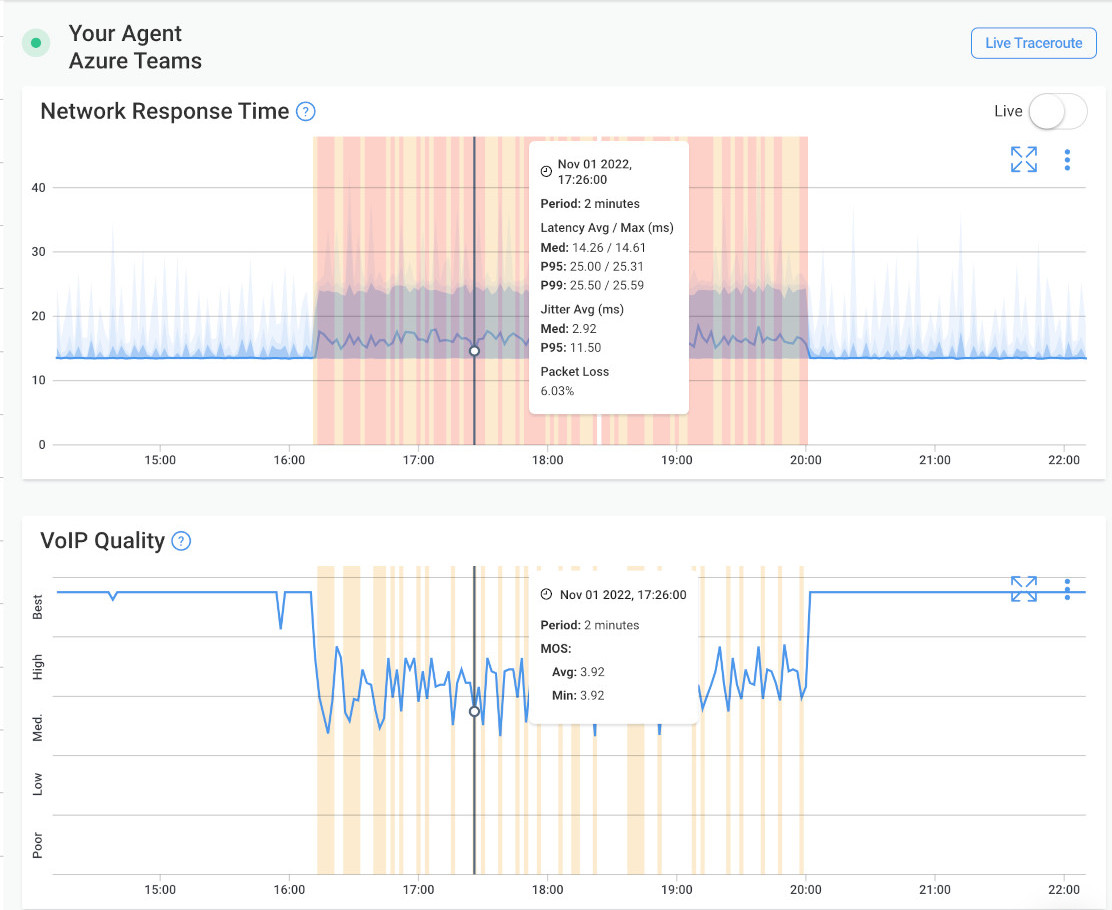
Use Obkio's Device Monitoring feature to monitor the performance of network devices. Obkio uses SNMP to gather information about the performance and behaviour of your network devices, including packet loss statistics. SNMP monitoring allows you to track and compare packet loss data over time, enabling you to identify trends, anomalies, or specific devices that may be contributing to the packet loss issue.
- Check routers, network switches, and cables for physical damage or loose connections.
- Review device logs for hardware errors or warnings.
When troubleshooting packet loss, it's essential to determine whether the issue is occurring only when communicating with specific destinations (websites, servers, services) or if it's affecting all connections across the network. To do this, test packet loss by connecting to different websites or services. This helps determine if the issue is localized to specific destinations.
- Select Multiple Destinations: Choose a variety of websites, online tools, or services from different locations. You might consider selecting websites hosted in different countries, or using online tools that offer packet loss tests.
Perform Ping or Traceroute Tests: Use the
pingcommand or traceroute tools to test the connectivity and packet loss to the selected destinations. For example:ping google.comThis sends a series of small packets to the destination and reports back the response time and packet loss rate.
Analyze Results:
- Look at the results of the ping or traceroute tests for each destination.
- Note the network response time (latency) and the packet loss percentage, if any.
When conducting these tests, there are a few potential outcomes:
- No Packet Loss Everywhere: If you observe no packet loss when testing connections to various destinations, it suggests that the issue might be intermittent or localized to certain times or paths.
- Packet Loss to Specific Destinations: If you notice packet loss when testing connections to certain websites or services but not others, it indicates that the problem might be related to the routing or infrastructure of those specific destinations.
- Packet Loss Everywhere: If you consistently experience packet loss across multiple connections to various destinations, the issue could be more widespread within your network.
Use traceroute (or tracert) to identify the path that packets take to reach their destination. You can use Obkio Vision, Obkio’s free Visual Traceroute tool that runs continuously to interpret Traceroute results to identify network problems in your WAN and over the Internet.
- Look for high latency or packet loss at specific hops along the route.
- If you are experiencing packet loss only towards a specific location over the Internet, it indicates that the issue is localized and impacting only the communication between your network and that particular site.
- If the packet loss issue is happening on your ISP’s side, and you need to open a service ticket with as much information as you can collect.
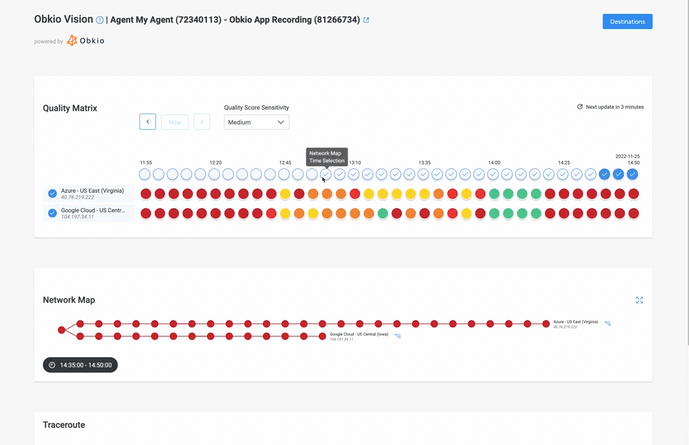
QoS is a network management technique that involves assigning different priorities to different types of network traffic. The goal is to guarantee a certain level of performance for critical applications, even when the network is under heavy load or congestion. QoS helps prevent situations where less important traffic consumes all available bandwidth, leading to latency, jitter, and packet loss for more time-sensitive applications.
Review QoS Settings:
1. Identify Critical Applications:
- Determine which applications or services are critical for your business operations or user experience. Examples include voice and video calls, video conferencing, remote desktop, and real-time data transmission.
2. Check Existing QoS Policies:
- Review the current QoS policies in place on your network equipment (routers, switches, firewalls).
- Ensure that the critical applications have appropriate priority settings assigned to them.
Adjust QoS Settings:
- Allocate Bandwidth: Allocate more bandwidth to time-sensitive applications. This helps ensure that these applications have the necessary resources to function smoothly, reducing the chance of packet loss.
- Traffic Classification: Differentiate between types of traffic based on their characteristics, such as voice, video, data, or web browsing. Set higher priority levels for real-time traffic that requires low latency and minimal packet loss.
- Queuing Mechanisms: Implement queuing mechanisms that prioritize high-priority traffic over lower-priority traffic during times of congestion.
- DSCP and CoS Marking: Use Differentiated Services Code Point (DSCP) or Class of Service (CoS) markings to identify and prioritize traffic at the packet level.
- Adapt to Network Conditions: Implement dynamic QoS adjustments that adapt to changes in network conditions. Some modern routers and switches offer adaptive QoS features.
If you're unable to resolve the issue, consider consulting with network professionals who can provide more specialized assistance. Additionally, some issues may be happening outside of your network, in your ISP or MSP network. In that case:
- Contact your Internet Service Provider (ISP) to inquire about any known issues or network outages in your area.
- Open a service ticket with as much information as you can collect, using screenshots from Obkio's app.
- Clearly communicate the impact of the packet loss on your network operations, highlighting any critical applications or services that are affected.
Remember that troubleshooting packet loss can be iterative and may require a combination of efforts. By systematically working through these steps and analyzing the results, you can identify the root causes of packet loss and take appropriate actions to address them.
Maintaining a reliable and efficient network is crucial for seamless communication and data transfer in today's interconnected world. Packet loss, the loss of data packets during transmission, can disrupt communication, degrade performance, and impact user experience.
While some levels of packet loss can be accepted and expected, high and ongoing packet loss can severely impact network and user experience. To ensure optimal network performance, it's essential to identify and mitigate the causes of packet loss.
In this section, we'll explore strategies and techniques to lower packet loss in your network. From testing packet loss to implementing quality of service (QoS) policies, reducing packet loss can enhance the reliability and quality of your network for both critical business operations and everyday communication needs."
Here are some steps that network administrators can take to reduce packet loss:
- Use Packet Loss Monitoring Tools: Network administrators can use packet loss detection tools, like Obkio Network Performance Monitoring tool, to monitor network performance and proactively identify where packet loss is happening on your network. With a tool like Obkio, you can also collect the data to identify what is causing the packet loss, and quickly troubleshoot.
- Check Network Hardware: Ensure that your routers, switches, and other network equipment are functioning properly and are up-to-date with firmware updates. Inspect cabling for damage, loose connections, or interference.
- Upgrade Bandwidth: If your network is consistently congested, consider upgrading your bandwidth to accommodate higher traffic loads.
- Use QoS and Prioritisation: IT professionals can optimize network performance by prioritizing traffic based on importance using QoS (Quality of Service) and CoS settings. QoS is commonly used in LANs, MPLS networks, Dual-WAN networks, SD-WAN networks and SASE architectures to prioritize and manage network traffic. By balancing the needs of different types of traffic and using network monitoring tools to identify packet loss, IT pros can minimize the impact of network traffic prioritization on packet loss and maintain optimal network performance and business productivity.
- Reduce Network Jitter: Jitter is variation in packet delay. Implement measures to reduce jitter, such as using Quality of Service (QoS) to prioritize real-time traffic.
- Implement Redundancy: Implement error correction mechanisms such as Forward Error Correction (FEC) to reconstruct lost data. By duplicating data packets and sending them through multiple routes, network redundancy can reduce the impact of packet loss, improving network performance and reliability.
- Increase Circuit Speed: By increasing circuit speed or the available bandwidth on the network, you can then reduce network congestion and minimize the likelihood of packet loss happening. This can be done by upgrading network hardware or ISP circuit speed, using link aggregation, or implementing Quality of Service (QoS) policies to prioritize network traffic.
- Upgrade Network Infrastructure: Consider upgrading older network infrastructure with modern equipment that supports higher speeds and better reliability. Ensure that network equipment and devices, such as routers, switches, and cabling, are up-to-date and working correctly to reduce the likelihood of hardware failures causing packet loss. And upgrade your network monitoring tool to better identify packet loss.
- Address Wireless Issues: If using wireless connections, optimize your Wi-Fi network by minimizing interference, adjusting channel settings, and placing access points strategically.
- Reduce Interference: Minimize electronic interference by keeping network equipment away from devices that emit electromagnetic interference, such as microwaves or cordless phones.
- Open A Service Ticket: If the packet loss is happening outside of your network (ex: in your Service Provider’s network), use the data provided by your Network Performance Monitoring tool to open a service ticket with your Service Provider for faster troubleshooting.
Reducing packet loss requires a combination of careful configuration, ongoing monitoring, and periodic adjustments to your network infrastructure. It's important to consider the specific needs of your applications and users to create a network environment that minimizes packet loss and ensures reliable communication and data transfer.


Are you tired of your network dropping packets like a clumsy waiter dropping plates? Well, fear not! There are steps you can take to reduce packet loss and improve network performance. From checking for physical network issues to implementing redundancy and packet loss recovery techniques, we've got the tips you need to keep your network running smoothly.
Improving packet loss in a network can be a complex task, but there are several steps you can take to reduce packet loss and improve overall network performance:
- Check for physical network issues: Physical issues such as damaged cables, loose connectors, or faulty network equipment can cause packet loss. Ensure that all network hardware is functioning correctly and replace any damaged cables or connectors.
- Optimize network bandwidth: If the network is congested, packets may be dropped due to the limited available bandwidth. You can optimize network bandwidth by implementing Quality of Service (QoS) policies, which prioritize critical traffic such as VoIP or video streaming.
- Update firmware and software: Ensure that network devices have the latest firmware and software updates. This can fix bugs and security vulnerabilities that can contribute to packet loss.
- Use packet loss recovery techniques: There are several packet loss recovery techniques that can be used to improve network performance, such as Forward Error Correction (FEC) or Automatic Repeat Request (ARQ).
- Implement redundancy: Implementing redundancy in the network can help reduce the impact of packet loss. Redundant links, devices, and paths can provide alternate routes for data to reach its destination, minimizing the impact of packet loss.
- Monitor network performance: Regularly monitoring network performance can help identify and troubleshoot issues before they impact end-users. Use specialized network monitoring tools that can capture and analyze network traffic in real-time to track packet loss and other critical metrics.
By following these steps, you can reduce packet loss and improve overall network performance, ensuring that data is transmitted reliably and efficiently across the network.
UDP (User Datagram Protocol) is a transport protocol used for sending data over a network. Unlike TCP (Transmission Control Protocol), which provides reliable, ordered, and error-checked data transmission, UDP is a simpler protocol that offers minimal error checking and no built-in mechanisms for ensuring delivery or sequencing of data packets.
This means that UDP packets can be lost in transit without any automatic retransmission.
UDP packet loss refers to the situation where some of the UDP packets sent from a source to a destination are not successfully received at the destination. This can occur due to various factors such as:
- Network congestion (WAN or LAN congestion)
- Hardware issues
- Or the inherent nature of UDP itself.
When UDP packets are lost, there is no automatic mechanism to detect the loss and request retransmission, unlike TCP where lost packets are retransmitted until they are successfully received.
Applications that use UDP are often those where speed and lower overhead are more important than guaranteed delivery, such as real-time streaming, online gaming, VoIP (Voice over Internet Protocol), and live video broadcasting. In these cases, a small amount of packet loss may be acceptable because retransmitting lost data could introduce unwanted latency.
However, excessive UDP packet loss in such applications can still result in degraded performance and poor user experience. For example, in online gaming, high UDP packet loss can lead to jitters and lag, making the game unplayable. In VoIP applications, lost voice packets can cause choppy or distorted audio.
Reducing UDP packet loss involves optimizing various aspects of your network and application setup to minimize the chances of packet loss occurring. While you can't eliminate UDP packet loss entirely (since UDP doesn't have built-in error recovery mechanisms like TCP), you can take several steps to mitigate its impact.
Here's how:
- Improve Network Quality: Ensure that your network infrastructure is reliable and properly configured. Address hardware issues and reduce network congestion to minimize the likelihood of packet loss.
- Prioritize UDP Traffic: Implement Quality of Service (QoS) settings to give priority to UDP traffic for real-time applications like VoIP, video streaming, and online gaming.
- Use Error Correction Techniques: Even though UDP itself doesn't have error correction, you can implement your own error correction techniques within your application. This could involve adding redundant information to packets or using forward error correction (FEC) mechanisms.
- Adjust Packet Size: Smaller packets have a better chance of being transmitted successfully, especially in scenarios where there's network congestion. Consider optimizing the size of your UDP packets.
- Use Packet Loss Concealment: Implement packet loss concealment algorithms in your application. These algorithms attempt to mitigate the impact of lost packets by smoothing out the playback of data and minimizing the perceptible effects of the loss.
- Monitor and Analyze: Use network monitoring tools to track UDP packet loss and identify patterns. This can help you pinpoint problematic areas in your network.
- Consider Redundancy: If feasible, send duplicate packets or use redundant paths to increase the chances of at least one packet arriving successfully.
- Minimize Jitter: Jitter (variation in packet delay) can contribute to packet loss. Implement measures to reduce jitter, such as buffering and proper timing management in your application.
- Use Reliable Protocols When Needed: Consider using TCP or other reliable protocols for critical data transfers, while utilizing UDP for real-time applications where slight packet loss is more tolerable.
- Optimize Application Performance: Optimize your application to minimize unnecessary data transmission and reduce the overall load on the network.
- Upgrade Network Infrastructure: If you consistently experience high UDP packet loss, consider upgrading your network equipment to handle higher loads and reduce latency.
- Test and Tweak: Continuously test your application's performance under different network conditions and adjust your settings accordingly.
It's important to remember that UDP is designed for scenarios where speed and low overhead are prioritized over guaranteed delivery. While these steps can help reduce UDP packet loss, some degree of packet loss might still be inevitable, especially in scenarios with challenging network conditions. Your approach should be tailored to the specific requirements and constraints of your application.
Congratulations, you've made it to the end of our packet loss journey! Now that you know what packet loss is, what causes it, and how to combat it, you're well on your way to a stronger and more reliable internet connection.
Remember, packet loss may be an invisible enemy, but it's not invincible. With the right tools and knowledge, you can defeat it and keep your business running smoothly. And don't forget, a strong and reliable internet connection can have a positive impact on your bottom line, so it's worth investing the time and effort to make sure you're in control of your network performance.

And you don’t have to do it alone! Obkio’s Network Performance Monitoring solution is a network administrator's best tool to:
- Proactively detect packet loss anywhere in your network
- Measure packet loss rates (acceptable vs high packet loss)
- Identify where and what is causing the packet loss
- Collect the data to troubleshoot packet loss and take the necessary actions
By reducing packet loss, businesses can improve network performance, increase productivity, and provide a better user experience.
Start identifying and troubleshooting packet loss now!













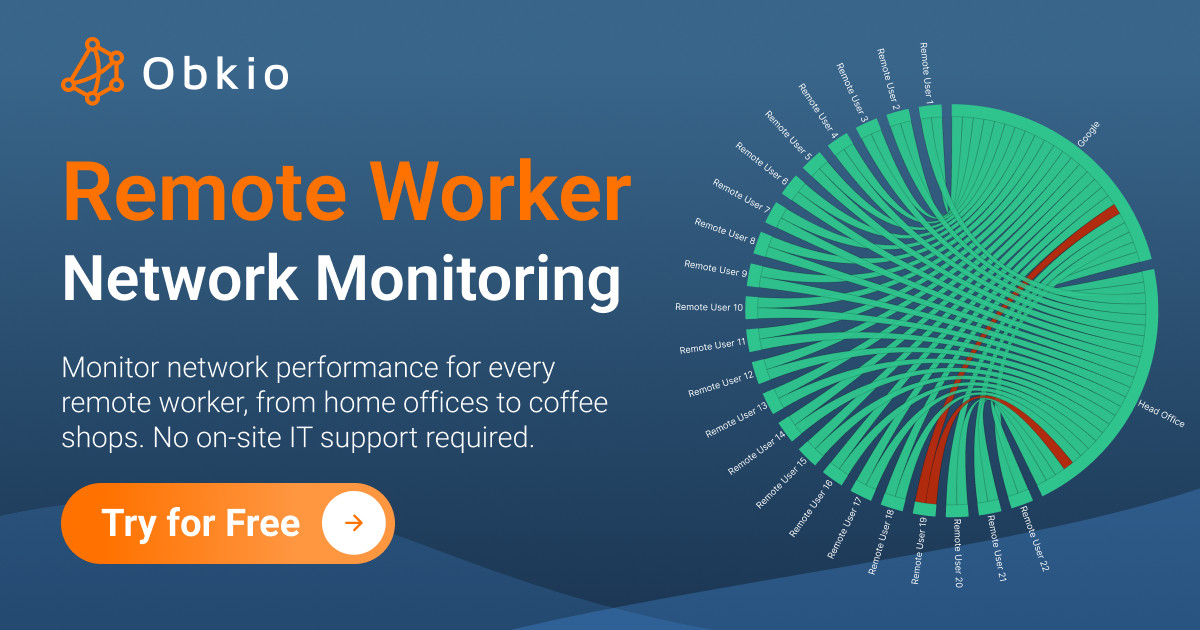













 Obkio Blog
Obkio Blog






